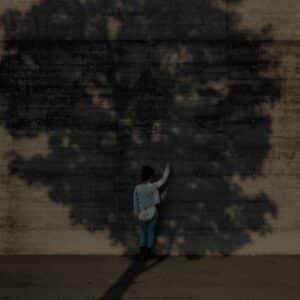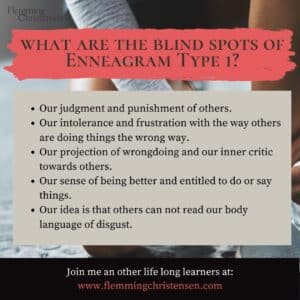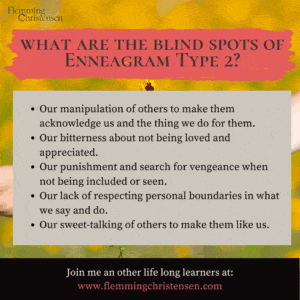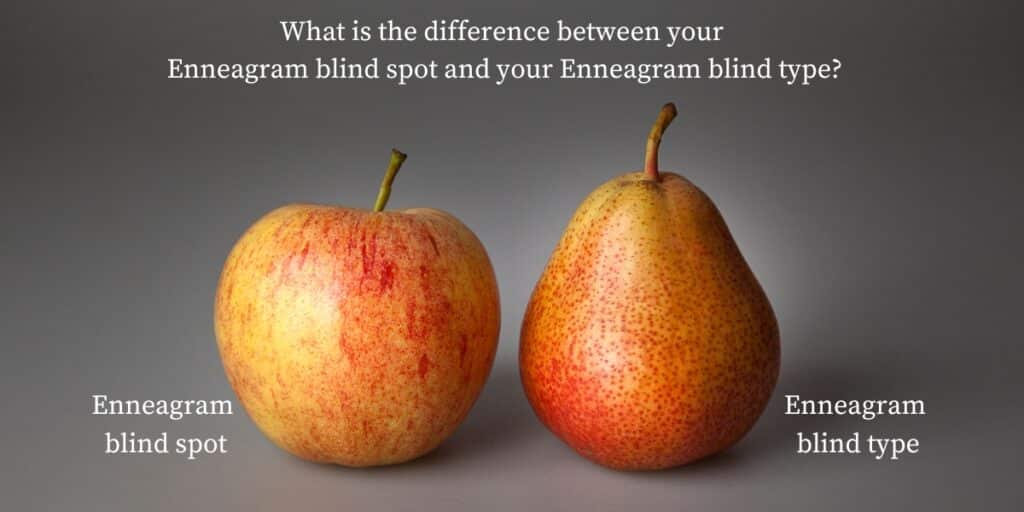The book “The enneagram and why your blind type matters” have now been out in bookstores and online shops for three months. Several readers are sending me questions about the blind Enneagram type and until now, I have received most questions about the difference between a blind Enneagram spot / shadows and blind Enneagram type. In this article, you can read more about the differences and similarities.
What is a shadow, and what is shadow work?
Psychological shadows are a form of hidden psychological baggage comprising of the unconscious thoughts, beliefs, and feelings that we carry with us but rarely take time to acknowledge or recognize.
(click here to receive your weekly question to empower your personal growth and development)
Your Enneagram shadows or Enneagram blind spots are elements of your personality that are not visible or conscious to you. And they will remain blind, invisible, neglected, or unconscious to you until you uncover them.
They range from negative to positive mental states, but although they remain inaccessible to conscious thought, their influence is far-reaching.
Unaddressed psychological shadows can manifest in physical ailments such as chronic pain, depression and anxiety but also misperspective of reality, overly optimistic / childish / naive and grandiosity ; they can also affect our relationships with family, friends and colleagues as well as our overall sense of wellbeing.
Awareness and understanding of psychological shadows are key steps towards bringing them into consciousness and ultimately managing them in healthy ways. Through self-reflection and intentional work, it is possible to find clarity on these often deeply hidden issues which can have profound effects on our lives.

By addressing psychological shadows, a person can gain greater control over their own emotions and behaviors and open up the possibility of more meaningful relationships with those around them. Ultimately, this can lead to improved mental health, increased self-esteem and more fulfilling life experiences.
Psychological shadows are an important area of exploration for anyone looking to gain greater insight into themselves and their behavior.
Acknowledging these deeply hidden issues is not easy, but it often leads to healthier thinking patterns and improved overall wellbeing. With time and effort, psychological shadows can become a source of strength rather than a weakness as we learn how to use them productively in our lives.
Through thoughtful consideration and acceptance of our shadows, we are able to live a fuller life and enjoy meaningful connections with others. Understanding the power of psychological shadows can open the door to a more vibrant and rewarding life experience.
Carl Jung and the Shadow
Carl Jung, a renowned psychoanalyst and one of the most influential thinkers of the 20th century, is best known for introducing the concept of psychological shadows. He proposed that we all have a darker side to our personality – an unconscious aspect known as the “shadow” – which contains repressed thoughts, emotions, and experiences that we have denied and suppressed. Jung argued that it is essential to recognize, explore, and reconcile the shadow if personal growth and psychological health are to be achieved.
Jung’s theories were groundbreaking in his time; he proposed a new way of understanding our inner worlds – and how important it was to understand them. According to Jung, by understanding and accepting our own shadows, we can learn about our unconscious motivations, fears, and desires, as well as uncover a more balanced and integrated sense of self. He believed that the journey to self-discovery required us to confront the unknown aspects of ourselves – even if they may be painful or uncomfortable.
Jung’s theories have heavily influenced psychoanalytic practice, and have become increasingly influential in modern psychology. He argued that the shadow is not to be feared – but must be faced and worked with in order to cultivate a healthier self-image and interior life.
Today, Jung’s ideas about shadows remain as relevant as ever; understanding the hidden aspects of our own shadows can lead to a more positive and meaningful life. By recognizing, exploring, and accepting our inner darkness – we can gain insight into our own unconscious motivations, desires, and fears – and ultimately move towards greater psychological health and self-discovery.
By understanding Jung’s concept of shadows – we are able to better understand ourselves and the mysterious depths of our own psyches. This understanding can help us to take greater control of our lives, and give us the courage to accept both the light and dark aspects of ourselves.
Although Carl Jung is speaking of “darkness”, I prefer to use the perspective of “something is placed in the shadows” being not so easy to identify what it is. Also I use the “darkness” together with the “brightness” as everything placed in the shadows is placed there for a reason and with a positive intention from our psyche.
When we discover and accept the positive intention with the part of our personality living in the shadows, we can use the patterns in a more beneficial way, often more aligned to the age and condition we are living in right now and not when the part or parts were pushed into the shadows.
What is an Enneagram blind spot?
In the Enneagram, each of the nine types represents a collection of behavioral, emotional, and cognitive patterns which are built for the purpose of making us feel safe. When we act out the patterns of our primary Enneagram type, we “feel as if we are ourselves”.
The purpose of our primary Enneagram type is to keep us attached or identified with our Ego or personality, and therefore there are blind spots to be found for each type. An Enneagram blind spot is a perspective or view of certain behaviors where we overdo the very qualities of the type. But we are not aware of the overuse, and therefore we talk about a blind spot.
Blind spot of Enneagram Type 1
We all fear to some degree, being wrong, sloppy, incorrect, being caught in not doing our best and not living up to the expectations around us.

This can include not seeing or denying:
- Our judgment and punishment of others.
- Our intolerance and frustration with the way others are doing things the wrong way.
- Our projection of wrongdoing and our inner critic towards others.
- Our sense of being better and entitled to do or say things.
- Our idea is that others can not read our body language of disgust.
Our excuse is that we want to make the world a better place, correcting all the errors and mistakes made by everyone around us.
Blind spot of Enneagram Type 2
We all fear to some degree, being unloved, unrecognized, unneeded, and with no particular significance to someone special.

This can include not seeing or denying:
- Our manipulation of others to make them acknowledge us and the thing we do for them.
- Our bitterness about not being loved and appreciated.
- Our punishment and search for vengeance when not being included or seen.
- Our lack of respecting personal boundaries in what we say and do.
- Our sweet-talking of others to make them like us.
Our excuse is that we want to do things from a pure heart, building and supporting healthy relationships where we are connected and assisting each other.
Blind spot of Enneagram Type 3
We all fear to some degree, being unaccomplished, frauds, failures, losers, and not excellent in anything.
To cover up that fear, the Enneagram Type 3 in all of us denies how we polish our self-image, create a positive spin on our achievements and hide our mistakes, failures, inabilities, and times when we did not reach our goals. We also cover up our inner real persona, because we might be afraid of the emptiness we find or that what is the real persona is not a success from other’s perspective.
This can include not seeing or denying:
- Our shaping the truth to fit our purpose.
- Our hiding our mistakes or softening what went wrong.
- Our self-sufficiency and appearing like we don’t need help, assistance, and support.
- Our chameleon-like compartmentalizing of our emotions.
- Our pragmatic attitude to problems focusing on fast wins.
Our excuse is that we want to achieve and be the best version of ourselves (and that this is what society wants).
Blind spot of Enneagram Type 4
We all fear to some degree, being without a core identity, original self, or authentic personality and just being a regular drop of water in the ocean.
To cover up that fear, the Enneagram Type 4 in all of us denies our attachment and identification with our emotions, we act like our emotions are true and are giving us the right to react or speak in a certain way. We explore our past experiences to see if there is a hint or clue about how we have become who we are, and spend time and energy to understand every aspect of our emotions… making us self-absorbed and the ones having a more difficult time than others.
This can include not seeing or denying:
- Our dramatic outbursts to get attention to our emotions.
- Our hijacking of the conversation bringing the focus on me and my experiences.
- Our sinking into negative emotions and thoughts, expecting others to follow us.
- Our envy of the way others are having a better relationship, better job, better pregnancy etc.
- Our experimenting with our own and others emotions.
Our excuse is that we want to become original and authentic and that everything that is not acting from realness and true personality has no worth.
Blind spot of Enneagram Type 5
We all fear to some degree, being ignorant and not understanding, having the knowledge or being able to find a solution to a problem. It is, in a sense, the feeling of being helpless or not finding a way out of a problem.
To cover up that fear, the Enneagram Type 5 in all of us denies striving for understanding and being knowledgeable, even if the prize is detachment, rejection, and disconnection. We look like we know it all, have mental power over things and have the answers to important questions. Rejecting and disconnecting from others help us be objective and not let our feelings interfere, but it just sends us deeper into our mental space and away from reality.
This can include not seeing or denying:
- Our disconnecting from the relationships without warning or explanation.
- Our arrogance and “know-it-all” attitude making others feel stupid and useless.
- Our obsession with certain ideas and searching for a truth that is no important.
- Our ascetic withdrawal and isolation are where we do not need anything or anyone.
- Our non-emotional and objective way of distancing us from real life.
Our excuse is that we want to trust the truth of reality, objective rationale, and clear thinking, not clouded with emotions.
Blind spot of Enneagram Type 6
We all fear to some degree, being caught in bad planning, not being able to foresee problems, and making stupid or unthoughtful decisions.
To cover up that fear, the Enneagram Type 6 in all of us denies being skeptical, seeing everything that might go wrong, spotting trouble or problems, and bringing everyone’s attention to all the ways things will end with trouble, waste of resources or chronic pain or malfunction. We express distrust, complaints, and lack of respect for others expecting them to make wrong decisions.
This can include not seeing or denying:
- Our skepticism, suspicion, and mistrust in others.
- Our attacking others if they don’t understand the urgency in the situation.
- Our attention to what can go wrong and not seeing or appreciating what goes well.
- Our hectic approach to tasks converting us to the project manager of the situation.
- Our insisting on fixing all the problems or errors before we can start the activities.
Our excuse is that we want to make sure that we are not wasting our resources, engaging in projects that will end badly, and making sure that unforeseen trouble does not enter our lives.
Blind spot of Enneagram Type 7
We all fear to some degree, being limited and losing our freedom, having physical, emotional, and cognitive pains or malfunctions that will prohibit us from experiencing everything we want to experience.
To cover up that fear, the Enneagram Type 7 in all of us denies being restless, initiating more than completing, escaping from reality and obligations, and avoiding responsibility and everything that will be a limitation. We distract ourselves from the beauty of the moment and find ways to stay optimistic, not facing real trouble. It is the search for happiness and freedom where the search becomes more important than understanding the happiness and freedom that is right here already.
This can include not seeing or denying:
- Our childish sense of humor often disrespecting others.
- Our initiation of activities without including essential people.
- Our unpredictability and unreliability.
- Our avoidance of trouble, pain, limitation, and unrealistic thinking.
- Our overly optimistic approach to critical situations.
Our excuse is that we want to secure our freedom and free choice and not let others kill our spontaneity and optimism.
Blind spot of Enneagram Type 8
We all fear to some degree, being weak, incompetent, and not able to have the power to take care of ourselves when we are in pain or trouble.
To cover up that fear, the Enneagram Type 8 in all of us denies our aggression and lust for power and domination. We don’t understand how our energy overwhelms or intimidates others, and our access to anger scares people away and often those we love.
This can include not seeing or denying:
- Our assertive and dominating energy.
- Our insensitivity and directness when telling the truth.
- Our seeking power and influence over situations, people, decisions etc.
- Our rejecting of others when they don’t appear with complete trust and fairness
- Our lack of empathy toward ourselves and others.
Our excuse is that we want to help others to see reality, and speaking directly and honestly, is only a simple help we offer to others who clearly need the help.
Blind spot of Enneagram Type 9
We all fear to some degree, being left out of the group, the imbalance around us, the separation from the people or things we are connected to and a fragmented life.
To cover up that fear, the Enneagram Type 9 in all of us denies our suppressed anger, our passive-aggressive way of getting things our way, accepting tasks that we don’t want to do and then not doing them, postponing them, and being deliberately forgetful.
This can include not seeing or denying:
- Our passive-aggressive attitude to problems and conflicts.
- Our not responding to relationship- and team-dynamics.
- Our denial of reality and not speaking up.
- Our being among other people and numbing out without really being there or being present.
- Our apathy towards conflicts, problems, and misunderstandings.
Our excuse is that we want to make our own decisions and not be forced to do what we don’t want to do. And if we do not engage, then others can not blame us for doing the wrong thing.
What is an Enneagram blind type?
Your “blind type” is the Enneagram type that normally has the lowest score when you take an Enneagram test. These are qualities of human behavior that, for whatever reason, have not yet been developed or nurtured in your life up to this point.
You possess the capacity to grow these abilities but have compensated with your ‘primary type’, which has seen you through day-to-day life so far. You might have the feeling that something is missing in your life, or that you should be doing something else but don’t know what it is or how to use your gifts and skills in a more original and personal way.
When working with the concept of “blind” type, one must adjust the way one thinks about personality and types. Your blind type is not visible to you, and there may be a lack of understanding or even aversion to it. As an example, when looking at Type 1 on the Enneagram, the qualities that Type 1 embodies responsibility, striving for high quality, and discipline. If a person does not relate or is blind to these qualities, they may have assumptions of being overwhelmed by responsibility or that discipline is too restrictive for creativity.
On the other hand, someone else might have an assumption that life is too short for taking on extra responsibilities and duties and should instead be enjoyed as much as possible. These different perspectives are created from experiences and upbringings, making it difficult to determine precisely how a ‘blind’ type may express itself.
What is the difference between Enneagram blind Spot, Shadows and Enneagram blind Types?
The difference between your Enneagram blind spot and your Enneagram blind type is simple. Your Enneagram blind spot has to do with your primary type, and the overall dynamic of the personality structure expressed through your primary Enneagram type.
Your blindness and shadows regarding your primary Enneagram type can be explored and worked on using traditional shadow work based on the theories of Carl Jung.
You can also use the work of Carl Jung in exploring and working on your blind Enneagram type, but it is the blindness or the shadows expressed – not from your primary Enneagram type – but from the type that is blind to you.
The dynamic between your primary and blind Enneagram type is called your Enneagram Life Theme, and is an archetypical theme or role that colors your professional and private relationships.
Bringing it all together, both working on your Enneagram blind spot and shadows, your Enneagram blind type, and your Enneagram Life Theme would be a powerful element in a coaching program.
(click here to read more about the training program, including the topic of the article)




